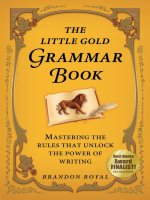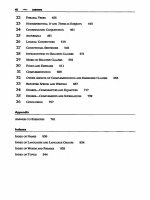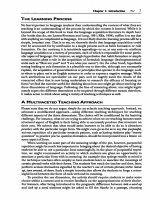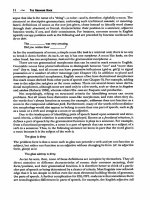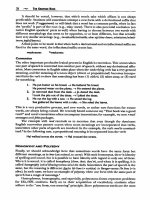The little gold grammar book mastering the rules that unlock the
Bạn đang xem bản rút gọn của tài liệu. Xem và tải ngay bản đầy đủ của tài liệu tại đây (1.32 MB, 218 trang )
THE
LITTLE GOLD
Grammar
Book
MASTERING THE RULES
THAT UNLOCK THE POWER
OF WRITING
Brandon Royal
Published by Maven Publishing
© 2010 by Brandon Royal
All rights reserved. No part of this work may be reproduced or transmitted
in any form or by any means, electronic or mechanicalâ—†œ âi†œncluding
photocopying, recording, or any information storage and retrieval
systemâ—†œ âw†œ ithout permission in writing from the author or publisher.
Reviewers, however, may quote brief passages in a review, and
individuals wanting to reference material from this book for academic
or non-commercial purposes may do so provided the book, with title
and author’s name, is cited as a source.
Published by:
Maven Publishing
4520 Manilla Road
Calgary, Alberta, Canad╇ T2G 4B7
www.mavenpublishing.com
Library and Archives Canada Cataloguing in Publication:
Royal, Brandon
The little gold grammar book : mastering the rules that unlock the
power of writing / by Brandon Royal.
ISBN 978-1-897393-30-7
Library of Congress Control Number: 2009909354
In addition to the paperback edition, this book is available as an eBook
and in the Adobe PDF file format.
Technical Credits:
Cover Design: George Foster, Fairfield, Iowa, USA
Editing: Jonathan K. Cohen, Irvine, California, USA
This book’s cover text was set in Minion. The interior text was set in
Scala and Scala Sans.
Contents
Introduction 5
Chapter 1: The 100-Question Quiz 7
Subject-Verb Agreement 8
Pronoun Usage 12
Modification 16
Parallelism 18
Comparisons 21
Verb Tenses 23
Diction Review 27
Idioms Review 29
Answers to The 100-Question Quiz 33
Chapter 2: Grammatical Munchkins 53
The Eight Parts of Speech 54
Parts of Speech vs. The Seven Characteristics 56
Other Grammatical Terms 58
Chapter 3: Word Gremlins 71
Diction Showdown 72
200 Common Grammatical Idioms 92
Chapter 4: Putting It All Together 99
30 All-Star Grammar Problems 100
Answers and Explanations 119
Editing I – Tune-up 147
Editing II – Punctuation Highlights 173
American English vs. British English 193
Traditional Writing vs. Digital Writing 201
Selected Bibliography 207
Index 209
About the Author
Introduction
This book is based on a simple but powerful observation:
Individuals who develop outstanding grammar skills do so
primarily by mastering a limited number of the most important
grammar rules, which they use over and over. What are these
recurring rules? The answer to this question is the basis of this
book.
In everyday writing, we may not always think it necessary to know
the intimate rules of grammar. As long as we reach our goal of
communicating through our writing, why is there need to know
precisely how everything works? After all, as long as we can drive
a car, why do we need to know how its engine works?
The individual who desires to become truly proficient in basic
writing skills needs to look under the “hood” to better understand
how the writing engine works. How do we navigate this
magnificent ensembleâ—†œ ât†œ he act of accurately stringing words and
word groups into sentences? The answer is part science and part
art. First, we review the common categories that capture the vast
5
majority of recurring grammar problems. Next, we familiarize
ourselves with the names of grammatical terms that describe the
words and word groups used in building sentences. Lastly, we
see how these parts interact as a whole by testing them through
multiple-choice problems that integrate key concepts.
Our journey would not be complete without coverage of a few
areas that closely impact “grammar.” These include: diction and
idioms, editing tips, American English versus British English,
and traditional writing versus digital writing.
This book is your “grammar mechanic’s” guide to writing.
Let’s get started.
Chapter 1
The 100-Question Quiz
The following 100-question quiz (Q1 to Q100) provides a highly
distilled review of grammar, diction, and idioms. The first
segment of this quiz addresses grammar and is built on the “big
six” grammar categories: subject-verb agreement, modification,
pronoun usage, parallelism, comparisons, and verb tenses. The
“big six” grammar categories provide a way to break grammar
into those areas where errors are most likely to occur. Once we
study the rules within each category, we can immediately apply
them to many practical writing situations.
7
THE LITTLE GOLD GRAMMAR BOOK
Subject-Verb Agreement
The overarching principle regarding subject-verb agreement is
that singular subjects require singular verbs while plural subjects
take plural verbs. Our objective is to identify the subject in order
to determine whether the verb is singular or plural.
Rule: “And” always creates a compound subject.
Q1 An office clerk and a machinist (was / were)
present but unhurt by the on-site explosion.
Note that the only connecting word that can make
a series of singular nouns into a plural subject
is “and.” In fact, “and” always creates a plural
subject with but one exception, as noted in the
next rule.
Rule: If two items joined by “and” are deemed to be
Q2 a single unit, then the subject is considered
singular, and a singular verb is required.
Eggs and bacon (is / are) Tiffany’s favorite
breakfast.
Rule: “Pseudo-compound subjects” do not make
Q3 singular subjects plural.
Pseudo-compound subjects include the following:
as well as, along with, besides, in addition to, and
together with.
A seventeenth-century oil painting, along with
several antique vases, (has / have) been placed on
the auction block.
8
Rule: THE 100-QUESTION QUIZ
Q4 Prepositional phrases (i.e., phrases introduced by
Rule: a preposition) can never contain the subject of a
sentence.
Q5
Q6 Note that some of the most common prepositions
Rule: include of, in, to, by, for, and from. A definition
of the word “preposition,” as well as a glossary
of other grammatical terms, can be found in
chapter 2.
The purpose of the executive, administrative, and
legislative branches of government (is / are) to
provide a system of checks and balances.
“There is/there are” and “here is/here are”
constructions represent special situations where
the verb comes before the subject, not after the
subject.
The normal order in English sentences is
subject-verb-object (think S-V-O). “There is/
there are” and “here is/here are” sentences are
tricky because they create situations in which
the verb comes before the subject. Thus, these
sentence constructions require that we look past
the verbâ—†œ Ⓠœ is” or “are” in this caseâ—†œ âi†œn order to
identify the subject.
Here (is / are) the introduction and chapters one
through five.
(Is / are) there any squash courts available?
When acting as subjects of a sentence, gerunds
and infinitives are always singular and require
singular verbs.
9
THE LITTLE GOLD GRAMMAR BOOK
Q7 Entertaining multiple goals (makes / make) a
Q8 person’s life stressful.
Exhibit 1.1
To plan road trips to three different cities (involves
/ involve) the handling of many details.
Chart of Indefinite Pronouns
Singular or Plural Examples
Certain indefinite pronouns Anyone, anybody, anything,
are always singular someone, something,
everyone, everybody,
Certain indefinite pronouns everything, every, one, no
are always plural one, nobody, nothing, each,
Certain indefinite pronouns either, neither
can be either singular or
plural Both, few, many, several
All, any, most, none, some
Rule: “-One,” “-body,” and “-thing” indefinite pronouns
Q9 are always singular.
One in every three new businesses (fails / fail)
within the first five years of operation.
Rule: Certain indefinite pronounsâ—†œ Ⓠbœoth,” “few,”
Q10 “many,” and “several”â—†œ âa†œ re always plural.
Few of the students, if any, (is / are) ready for the
test.
10
Rule: THE 100-QUESTION QUIZ
Q11
Q12 “Some” and “none” indefinite pronouns may be
Q13 singular or plural.
Rule:
Q14 Some of the story (makes / make) sense.
Q15
Rule: Some of the comedians (was / were) hilarious.
Q16 None of the candidates (has / have) any previous
Q17 political experience.
Rule:
In “eitherâ•›…â•›or” and “neitherâ•›…â•›nor” constructions,
the verb matches the subject which comes directly
after the “or” or “nor.”
Either Johann or Cecilia (is / are) qualified to act
as manager.
Neither management nor workers (is / are)
satisfied with the new contract.
Collective nouns denote a group of individuals
(e.g., family, government, assembly, crew). If the
collective noun refers to a group as a whole or
the idea of oneness predominates, use a singular
verb. If not, use a plural verb.
Our group (is / are) meeting at 6 p.m.
A group of latecomers (was / were) escorted to
their seats.
“The number” is a singular noun and takes a
singular verb. “A number” is plural and takes a
plural verb.
11
THE LITTLE GOLD GRAMMAR BOOK
Q18 The number of road accidents (has / have)
decreased.
Q19 A number of train accidents (has / have)
occurred.
Rule: Percents or fractions, when followed by an “‘of’
phrase,” can take a singular or plural verb. The
Q20 key lies in determining whether the noun within
Q21 the “‘of’ phrase” is singular or plural.
Fifty percent of video gaming (is / are) having
great reflexes.
Two-thirds of their classmates (has / have) wake�
boards.
Rule: Measurements involving money (e.g., dollars,
pounds), time (e.g., five years, the fifties), weight
(e.g., pounds, kilograms), or volume (e.g., gallons,
kilograms) are always singular and take singular
verbs.
Q22 Ten dollars (is / are) an average daily wage for
many people in the developing world.
Pronoun Usage
Problems relating to pronoun usage typically center on personal
pronouns. Three areas of confusion may include: choosing
between the subjective or objective forms of personal pronouns,
making sure pronouns agree in number with their antecedents,
and ensuring that pronouns are not ambiguous in context.
12
THE 100-QUESTION QUIZ
Exhibit 1.2 Chart of Personal Pronouns
Subjective Possessive Objective
my, mine me
first-person I
singular you your, yours you
he, she, it him, her, it
second-person we his, her, us
singular you hers, its
they
third-person our, ours
singular
your, yours you
first-person
plural their, theirs them
second-person
plural
third-person
plural
who who whose whom
Rule: As a general guide, pronouns at or near the
front of a sentence take their subjective forms;
Q23 pronouns at or near the back of a sentence take
Q24 their objective forms. The precise rule, however,
is that pronouns take their subjective form when
they are subjects of a verb; they take their objective
form when they are objects of a verb.
The present is from Beth and (she / her).
Cousin Vinny and (he / him) are both valedic�
torians.
13
THE LITTLE GOLD GRAMMAR BOOK
Rule: Pronouns take their objective form when they are
Q25 the direct objects of prepositions.
Q26
Q27 Between you and (I / me), this plan makes a lot of
sense.
Do not ask for (who / whom) the bell tolls.
People like you and (I / me) should know better.
Rule: When forming comparisons using “than” or
“asâ•…› â•a› s,” supply any “missing words” (e.g., a verb
Q28 in the examples below) in order to determine
Q29 whether the subjective or objective form of the
Q30 pronoun is correct.
My son is more sports minded than (I / me).
We skate as fast as (they / them).
During our group presentation, our teacher asked
you more questions than (I / me).
Rule: Who vs. Whom. “Who” is the subjective form of
the pronoun, and “whom” is the objective form
Q31 of the pronoun. If “he,” “she,” or “they” can be
Q32 substituted for a pronoun in context, the correct
form is “who.” If “him,” “her,” or “them” can be
substituted for a pronoun in context, the correct
form is “whom.”
The woman (who / whom) is responsible for
pension planning is Mrs. Green.
This gift is intended for (who / whom)?
14
Rule: THE 100-QUESTION QUIZ
Q33
Q34 Do not use a reflexive pronoun (a pronoun ending
in “-self”) if an ordinary personal pronoun will
suffice.
The tour leader told Julie and (me / myself) to
turn off our cell phones.
Young Robert hurt (him / himself) while climbing
alone.
Rule: Pronouns must agree in number with their
Q35 antecedents.
Q36
A not-for-profit, like any other organization, has
(its / their) own rules and regulations to follow.
Everybody should mind (his or her / their) own
business.
Rule: Pronouns should not be ambiguous in context.
If a pronoun does not refer clearly to a specific
noun, it results in a situation of “ambiguous
pronoun reference.”
Ambiguous: Sam never argues with his father when he is
drunk.
Q37 Sam never argues with his father when ________
is drunk.
Rule: “Pronoun shifts,” also known as “shifts in point
of view,” involve the inconsistent matching of
pronouns, either in terms of person or number.
Within a single sentence (and perhaps within an
entire paragraph or writing piece), first person
15
THE LITTLE GOLD GRAMMAR BOOK
should be matched with first person, second
person matched with second person, and third
person matched with third person. A common
violation involves matching the third-person
“one” or “a person” with the second-person “you.”
Another violation involves matching the third-
person singular “he,” “she,” “one,” or “a person”
with the third-person plural “they.”
Incorrect: To know that a person can’t vote is to know that
you don’t have a voice.
Q38 To know that a person can’t vote is to know that
________ have a voice.
Incorrect: One cannot really understand another country
until they have studied its history and culture.
Q39 One cannot really understand another country
until ________ studied its history and culture.
Modification
Modifiers, including modifying phrases, must be placed as close
as possible to the nouns they modify. As a mostly uninflected
language, English depends heavily on word order to establish
modifying relationships. Therefore, the position of words is
important. Confusion occurs because most modifiers attach
themselves to the first things they can “get their hands on” in the
sentence, even if it isn’t the right thing.
Rule: A misplaced modifier refers to a word which,
because of its placement within a sentence, no
longer modifies what it originally was intended
to modify.
Incorrect: He told her he wanted to marry her frequently.
16
Q40 THE 100-QUESTION QUIZ
Incorrect:
He __________ told her he wanted to marry her.
Q41
Coming out of the wood, the janitor was surprised
to find termites.
The janitor was surprised to find termites ______
_____________________________.
Rule: A dangling modifier refers to a situation in which
the thing being modified is absent from the
Incorrect: sentence.
Q42
Incorrect: After writing the introduction, the rest of the
Q43 report was easy.
After writing the introduction, __________ easily
drafted the rest of the report.
Walking along the shore, fish could be seen
jumping in the lake.
Walking along the shore, __________ could see
fish jumping in the lake.
Rule: Occasionally, a modifier or modifying phrase
may accidentally be placed where it could modify
Incorrect: either of two worlds or phrases. This situation
Q44 results in a “squinting modifier.” The writer
should consider rewriting this sentence to clear
up this ambiguity.
She said in her office she had a copy of the map.
She said she had __________ lying in her office.
17
THE LITTLE GOLD GRAMMAR BOOK
Rule: Whenever a sentence opens with a phrase or
clause that is set off by a comma, check to make
sure that the first word that follows the comma is
properly being modified by the opening phrase
or clause that precedes it.
Incorrect: In addition to building organizational skills, the
summer internship also helped me hone my
team-building skills.
Q45 In addition to building organizational skills, ___
________________________________________.
Incorrect: An incredibly complex mechanism, there are
some 10 billion nerve cells in the brain.
Q46 An incredibly complex mechanism, __________
has some 10 billion nerve cells.
Incorrect: Based on our observations, the project will
succeed.
Q47 ________________________________________.
Parallelism
Parallelism is both a style issue and a grammar issue. In other
words, certain elements of parallelism are based on principle (and
are deemed to be more effective or less effective, better or worse)
while other elements are based on rules and are considered
correct or incorrect, right or wrong.
The overarching principle regarding parallelism is that similar
elements in a sentence must be in similar form.
Rule: Verbs should follow consistent form. Typically
this means that all verbs should end in “-ed” or
“-ing.”
18
Incorrect: THE 100-QUESTION QUIZ
Q48
In the summer before college, Max was a waiter
at a restaurant, pursued magazine sales, and even
had a stint at delivering pizzas.
In the summer before college, Max __________
tables, __________ magazines, and even
__________ pizzas.
Rule: When prepositions are used before items in a
series of three, there are two possibilities with
Incorrect: regard to their use. Either a single preposition
Q49 is used before the first item in a series (but not
Q50 with the next two items) or prepositions are used
before each item in the series.
Our neighbors went to London, Athens, and to
Rome.
Our neighbors went ________ London, Athens,
and Rome.
Our neighbors went ________ London, ________
Athens, and ________ Rome.
Rule: Correlative conjunctions (e.g., eitherâ•›…â•›or, nei
therâ•›…â•›nor, not onlyâ•›…â•›but also, bothâ•›…â•›and) require
Incorrect: that parallelism be maintained after each
Q51 component part of the correlative.
Q52
Jonathan not only likes rugby but also kayaking.
Jonathan ________________________ rugby but
also kayaking.
Jonathan ________________________ rugby but
also ________ kayaking.
19
